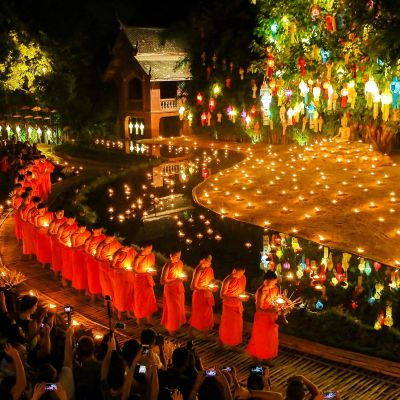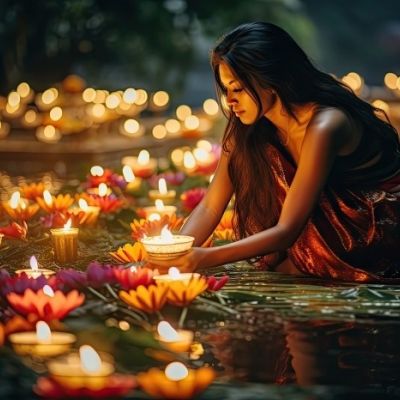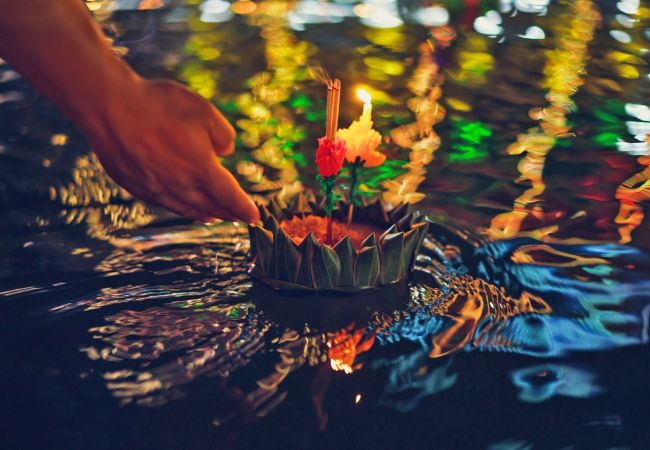Loy Krathong (Thai: ลอยกระทง, RTGS: Loi Krathong, pronounced [lɔ̄ːj krā.tʰōŋ]) is a Thai holiday held yearly across Thailand and adjacent countries with strong South Western Tai traditions (Laos, Shan, Mon, Tanintharyi, Kelantan, Kedah, and Xishuangbanna). The word might be interpreted as “to float ritual vessel or lamp,” and derives from the habit of crafting krathongs or buoyant, painted baskets that are subsequently floated on a river.
The phrase “Loy Krathong” is derived from the words “loy” (meaning “to float”) and “krathong” (referring to a sort of miniature, floating religious gift). True to its name, the festival’s main attraction is the floating of krathongs over small and big bodies of water around the nation. The goal of this act differs according to traditions and beliefs, but may be broadly characterized as follows:
- Worship Phra Mae Khongkha
- Worship of Lord Buddha
- Worship of Venerable Upagupta
- Worship of Lord Vishnu
- Worship of Ancestors
History
It is widely believed that Loy Krathong started under the Sukhothai Kingdom (1238-1438). The ancient literature Tamrap Thao Si Chulalak [ตํารับท้าวศรีจุฬาลักษณ์] talks about a woman called Nang Noppamas who was a high-ranking concubine of the King of Sukhothai. During an annual event in which royals gave votive floats in honor of the Buddha, Nang Noppamas created a beautiful float fashioned like a lotus and ornamented with small birds. This float later constituted the foundation for the krathong. The narrative also inspired another popular Loy Krathong tradition: Nang Noppamas-themed beauty pageants.

Academics, on the other hand, think that Loy Krathong’s beginnings predate the Sukhothai era. According to Historian Prince Damrong Rajanubhab (1862-1943), the story of Tamrap Thao Si Chulalak was most likely written later, during the time of King Nangklao (1824-1851). Thus, the connection of krathongs with Nang Noppamas may have been formed by subsequent generations.
Festivals and rituals involving the floating of offerings are common across Southeast Asia and may even be seen in East Asia. People in the Southeast have long believed in ghosts who live in water and on land. To express gratitude to these spirits, individuals would make tiny gifts in vessels made of banana leaves or stems and set them on the ground or in waterways. It is uncertain when or where the practice of floating offerings originated, however, the oldest depictions of the ritual may be found in Bayon, Cambodia, going back to approximately 1208. When Buddhism and Hinduism arrived in the area, the gifts became objects of devotion for Buddha and Hindu deities rather than native spirits. Other historians claim that the components of Loy Krathong were inspired by the Chinese tradition of floating paper lanterns.
When Is the Loy Krathong Festival Celebrated?
Loy Krathong Festival is held on the evening of the 12th full moon in the Thai lunar calendar. It generally occurs in November, according to the Western calendar. As a result, the Loy Kratong date is subject to change. It varies each year based on the full moon.
Loy Krathong Festival 2024: 16th November

How Is Loy Krathong Celebrated In Thailand?
Loy Krathong is a bright and prominent Thai celebration. Here’s how people usually celebrate this festival:
1. Krathong crafting:
Traditionally, Thai people start the holiday by crafting Krathongs at home with friends and family, however many also purchase them from local stores.
2. Floating Krathongs:
At sunset, people congregate near water bodies to display their adorned krathongs. They light the candles and incense before carefully releasing the krathongs into the water, representing the discharge of negativity and respect for the water spirits. According to Thai legend, if the krathong is lit until it vanishes out of sight, it would bring good luck the next year.
3. Cultural Performances and Beauty Pageant:
Visitors to Loy Krathong may enjoy folklore performances, lantern parades, fireworks displays, and Thai classical music concerts. There will frequently be a beauty contest in which ladies would dress in traditional Thai attire.

4. Lantern Release:
In certain areas of Thailand, such as Chiang Mai, an extra custom includes releasing floating lanterns known as “khom loi” into the sky. These lanterns represent the release of worry and the desire for a better future.
5. Food and Entertainment:
Loy Krathong is also a time for feasting. People often eat great street food, including local specialties and traditional Thai meals.
